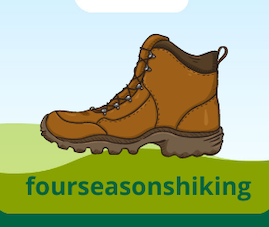Improving hiking endurance isn’t just about adding miles to your trail adventures; it’s about enhancing your overall experience and ensuring you can enjoy nature’s splendors without unnecessary fatigue. Neglecting this aspect of preparation can turn what should be an invigorating activity into a grueling slog. I know because I’ve been there.
As far as any exercise mentioned in this article, we suggest checking with your doctor first.
Before you lace up your boots and set off, take a moment to honestly evaluate your fitness level. No two hikers are the same, and your training should reflect your starting point. If the thought of a steep incline leaves you breathless, include more cardio-focused exercises in your regime. On the other hand, if you’re gasping after a few miles, it’s the distance that you’ll want to build gradually.
One proven method to boost hiking endurance is to integrate daily walking into your life. If you’re thinking that walking sounds too simple to be effective, remember that consistency is your ally. Regular walks, especially those that mimic trail conditions, can prepare your body for the demands of longer hikes.
Cross-training also plays a crucial role. Engaging in activities like cycling, and swimming, can fortify different muscle groups while giving your primary hiking muscles a well-deserved break. This not only minimizes injury risks but can also lead to better hiking efficiency.
As you proceed, set goals that feel right for you. Whether it’s reaching a certain distance or conquering a specific trail, having a target keeps you focused and fuels your motivation. But keep those goals flexible; the journey to upping your endurance is just as important as the achievements along the way.
Training Techniques for Hiking Fitness
Increasing your hiking endurance is a step-by-step process that requires a tailored training regimen. Building endurance is much like constructing a building \’ you need a solid foundation, quality materials, and a gradual building process. That’s why progressive overload, an essential approach in exercise, is your starting point. By slightly increasing your hiking distances, or adding weight to your backpack over time, your body adapts to the demands, fostering stamina and strength.
Now, let’s integrate interval training into your routine. By alternating between high and low-intensity periods, you encourage your heart and muscles to adapt to changing demands. Imagine you’re on a trail that includes flat paths and steep inclines. Interval training mimics these conditions, preparing you for the fluctuations in intensity you’ll encounter during a hike.
Of course, hiking isn’t all about cardiovascular fitness; your muscles play a major role, too. Strength training targets the muscle groups used most when hiking-like your quads, calves, and glutes. Incorporate exercises like squats, lunges, and step-ups into your weekly regimen to improve overall muscular endurance. This training helps prevent injuries that could set your hiking plans back.
Giving your body time to recover is also critical. Rest days are when the magic happens – your muscles repair and grow stronger. Take time to rest, especially if you’re sore or fatigued. Do low-impact activities like stretching on these days to aid recovery.
Lastly, don’t overlook nutrition and hydration. Eating a balanced diet ensures your body gets the necessary fuel. Hydration is equally critical, so carry water on your training hikes to get used to the added weight and to practice drinking on the move. Munch on some trail mix or a banana for a quick energy boost during longer walks.
Advanced Strategies for Seasoned Hikers
To take your hiking endurance to the next level, you’ll do well to focus not just on distance, but also on the kind of terrain you’re conquering. Including varied elevation in your training challenges your body, improving both your aerobic capacity and leg strength. When possible, choose routes with hills or stairs to mimic the demands of mountainous trails.
It’s not just about the physical landscape but also about adapting underfoot. Incorporate different surfaces such as sand, gravel, and rocky paths into your training regime. This doesn’t just ready your legs for varied hikes; it trains you to stay on your feet when the trail gets tricky.
Let’s talk about pace. Find your rhythm and maintain steady breaths to conserve energy, allowing you to hike longer and more comfortably. I suggest practicing breathing exercises and adopting a pace that matches your current fitness level, then gradually increasing the intensity as you improve.
Physical endurance is one half of the equation; the other half is mental toughness. Techniques like visualization, setting mini-goals, and positive self-talk can significantly influence your performance. Train your mind to endure, and your body will follow.
As far as any exercise mentioned in this article, we suggest checking with your Doctor first.
Lastly, it’s crucial to keep an eye on your development. Regularly assess your hikes. Are they getting easier? Can you go farther? Adjust your training accordingly to ensure you’re always pushing your boundaries, safely and effectively. Every hike is a learning experience, so use it to refine your approach towards endurance.
In compliance with the FTC guidelines, please assume the following about links and posts on this site: Any/all of the links fourseasonshiking.com are affiliate links of which I receive a small compensation from sales of certain items.
https://osprey.pxf.io/c/5564501/1765694/20745

Learn More- Click Link above


I really enjoyed your article on improving hiking endurance. You nailed the importance of preparation—it’s not just about logging miles but making sure the entire experience is enjoyable and not exhausting. I’ve definitely had hikes where I underestimated the effort required and paid the price!
Overall, your article provides a well-rounded, practical guide to boosting hiking endurance. It’s clear, actionable, and relatable. Thanks for sharing these insights—it’s definitely going to help make hiking a more enjoyable and rewarding experience for many!
Yes, I too, have attempted excursions that tested my limits. Thank you!
Sincerely, Lonnie
The guide on Four Seasons Hiking offers practical tips for building hiking endurance, covering aspects like pacing, strength training, and proper nutrition. As an avid hiker, I’ve found that incorporating regular cardio and leg workouts significantly improved my stamina on longer trails. The article’s advice on gradually increasing hike difficulty also resonates with my experience—it’s key to avoid burnout and injuries. If you’re aiming to enhance your hiking endurance, this guide provides a solid approach to achieving your goals.
Thanks for your comment and insight into your experience in hiking in the great outdoors!
Lonnie